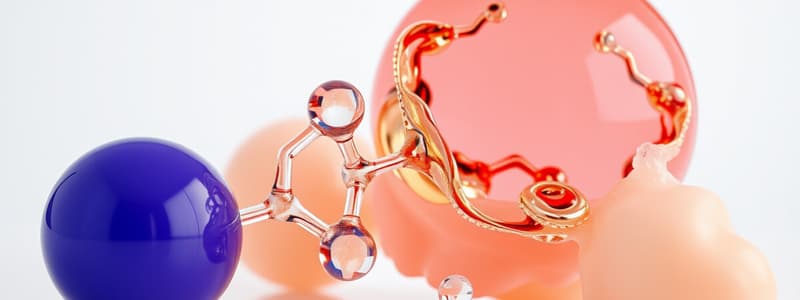Podcast
Questions and Answers
What does the kinetic molecular model explain about the properties of liquids and solids?
What does the kinetic molecular model explain about the properties of liquids and solids?
It explains the arrangement and behavior of particles in liquids and solids.
Which of the following properties of liquids is affected by intermolecular forces?
Which of the following properties of liquids is affected by intermolecular forces?
- Surface tension
- Viscosity
- Vapor pressure
- All of the above (correct)
The structure of crystalline solids is less ordered than that of amorphous solids.
The structure of crystalline solids is less ordered than that of amorphous solids.
False (B)
Describe how gases, liquids, and solids differ in terms of particle distance.
Describe how gases, liquids, and solids differ in terms of particle distance.
The property of matter that corresponds to the molecular behavior is called ___.
The property of matter that corresponds to the molecular behavior is called ___.
What is the significance of the bond polarity in a molecule?
What is the significance of the bond polarity in a molecule?
In increasing distance between particles, which phase of matter comes first?
In increasing distance between particles, which phase of matter comes first?
Match the phase of matter with its corresponding property of motion:
Match the phase of matter with its corresponding property of motion:
Liquids have a fixed shape and volume.
Liquids have a fixed shape and volume.
Study Notes
Kinetic Molecular Model
- Describes the behavior of solids, liquids, and gases based on particle motion and arrangement.
- In solids, particles are closely packed and vibrate in fixed positions.
- In liquids, particles are close but can flow past each other, exhibiting more freedom of movement.
- In gases, particles are far apart and move freely, resulting in high compressibility and low density.
Intermolecular Forces
- Intermolecular forces vary in strength and types, affecting the properties of substances:
- Dipole-Dipole: Attraction between polar molecules.
- Hydrogen Bonding: Stronger attraction in molecules containing hydrogen bonded to electronegative elements (O, N, F).
- London Dispersion: Weak forces present in all molecules, stronger in larger atoms.
Properties of Liquids
- Surface Tension: Caused by cohesive forces; liquefies at the surface creating a minimal area.
- Viscosity: Resistance to flow; affected by temperature and intermolecular attractions.
- Vapor Pressure: Pressure exerted by vapor above a liquid; increases with temperature and decreases with stronger intermolecular forces.
- Boiling Point: Temperature at which vapor pressure equals atmospheric pressure; influenced by intermolecular forces.
- Molar Heat of Vaporization: Energy required to convert a mole of liquid to gas; greater for liquids with stronger intermolecular forces.
Properties of Water
- Water’s unique structure (polar molecule) results from its hydrogen bonding, leading to high surface tension, specific heat capacity, and boiling point compared to other substances.
Solid Structures
- Crystalline Solids: Atoms or molecules arranged in a repeating pattern, characterized by distinct melting points.
- Amorphous Solids: Lack a definite structure, with particles arranged randomly; exhibit a range of melting points.
Molecular Behavior of Matter
- Density: Greatest in solids, intermediate in liquids, least in gases.
- Compressibility: Low in solids, moderate in liquids, high in gases.
- Movement of Molecules: Restricted in solids, more fluid in liquids, and rapid in gases.
Classroom Activity
- Roleplay exercise to illustrate differences between solids, liquids, and gases by acting out particle arrangements and movements.
- Groups discuss and present characteristics such as arrangement and motion for respective phases.
Ranking Molecular Distances
- Increasing Distance: Solid < Liquid < Gas
- Molecules in solids are closest together, while gas molecules are farthest apart.
Comparison Activity
- Utilize a matching activity to distinguish between properties of solids, liquids, and gases according to their characteristics like shape, volume, and expansion behavior.
Studying That Suits You
Use AI to generate personalized quizzes and flashcards to suit your learning preferences.
Related Documents
Description
This quiz covers key concepts in General Chemistry 2, focusing on the kinetic molecular model to explain the properties of liquids and solids. It also explores different types of intermolecular forces and their effects on various properties like surface tension and boiling point. Test your understanding of the fundamental principles that govern the behavior of substances in different states.




